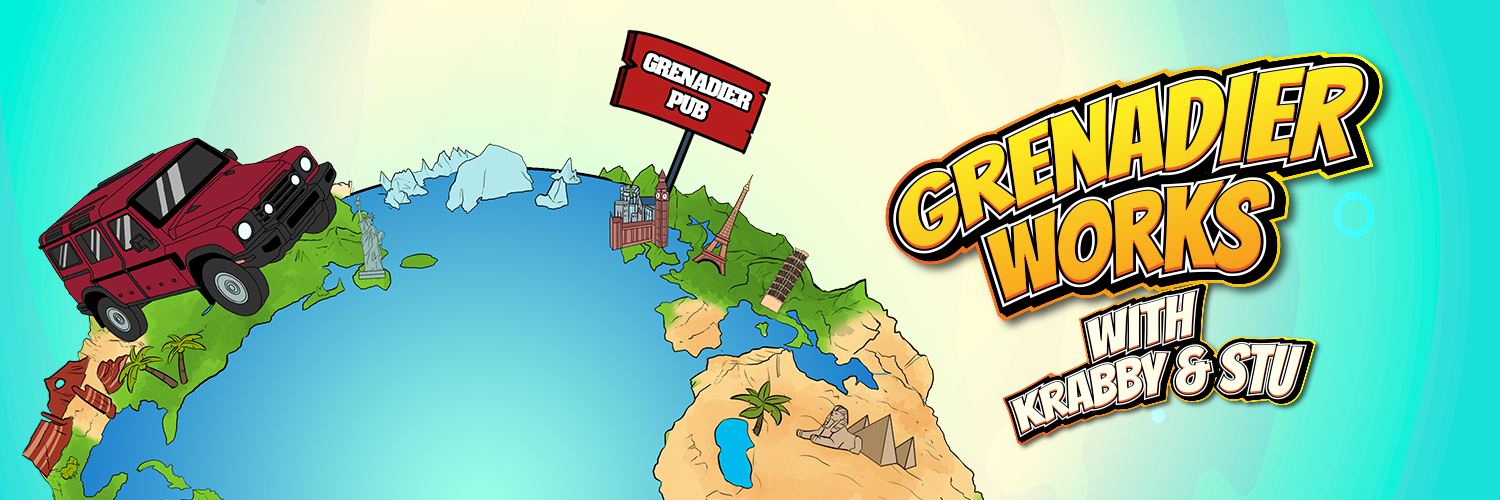Another (very expensive) option would be to maintain all the stock suspension geometry and install portal axles. I know LeTech engineered some and Jay at Dirtbox Overland/Couch Offroad is working on some.
The Grenadier Forum
Register a free account today to become a member! Once signed in, you'll be able to contribute to the community by adding your own topics, posts, and connect with other members through your own private inbox! INEOS Agents, Dealers or Commercial vendors please use the contact us link at the bottom of the page.
You are using an out of date browser. It may not display this or other websites correctly.
You should upgrade or use an alternative browser.
You should upgrade or use an alternative browser.
For those considering a suspension lift , here is my front prop shaft at full suspension drop
 whilst on the lift at the Ineos dealership, well within acceptable levels but with an added suspension lift the CV joint may be at too extreme an angle
whilst on the lift at the Ineos dealership, well within acceptable levels but with an added suspension lift the CV joint may be at too extreme an angle 
For those people that have had the drive shaft failure and have a lift, has Ineos denied warranty coverage? If so, was it in the US or some other country?
I don't know why the design has the exit from the diff at an angle that is so close to parallel with road - it seems like if the axle had been designed so that the exit from the diff was tilted so that better aligned with the angle from the drive shaft, that would have put a lot less stress on the system. I wouldn't think that the axel cares if the diff is angled upward, does it?For those considering a suspension lift , here is my front prop shaft at full suspension drop View attachment 7870008whilst on the lift at the Ineos dealership, well within acceptable levels but with an added suspension lift the CV joint may be at too extreme an angle
out of pocket for me. dealer just said that because of the modification(lift) it wasn't covered. didn't pursue it further.For those people that have had the drive shaft failure and have a lift, has Ineos denied warranty coverage? If so, was it in the US or some other country?
The total range of operating angle for the drive shaft does not change but after installing the Eibach springs the shaft runs continuously at a higher angle than when at the stock height. The theory is that this overheats the CV boot (when driving at highway speeds) which causes it to fail, then the grease flings out and that causes the joint to fail.According to Eibach, full extension is controlled by shock travel, not by the spring. If this is true, the spring lift should not exacerbate the problem correct?
This is true, however, it is spending more time at a steeper angle because the ride height is different than stockAccording to Eibach, full extension is controlled by shock travel, not by the spring. If this is true, the spring lift should not exacerbate the problem correct?
Agreed.According to Eibach, full extension is controlled by shock travel, not by the spring. If this is true, the spring lift should not exacerbate the problem correct?
Yes the taller ride height increases the steady state angle of the CV joint. At highway speeds this can overheat the CV boot. If the boot remains intact then this increased angle is not likely to cause an issue as the CV joint is still within its operational limit. The question is why some owners are experiencing boot failure and others are not.This is true, however, it is spending more time at a steeper angle because the ride height is different than stock
That angle (long term) just looks scary to me. From an orthopedic standpoint just not good for longterm function.For those considering a suspension lift , here is my front prop shaft at full suspension drop View attachment 7870008whilst on the lift at the Ineos dealership, well within acceptable levels but with an added suspension lift the CV joint may be at too extreme an angle
One consideration on how far they can pivot the pinion up probably has to do with the clearance between the diff/pinion and oil sump. If you look under your vehicle even in its stock configuration and imagine the axle articulating upwards the pinion housing and driveshaft gets very close to those components. My guess is this is a limitation on how far they could ultimately tilt it up so very much a packaging consideration for leaving enough space for full axle articulation.
There's some nonsense above the front differential pinion to be sure (fuel lines, oil sensor wires, maybe even the engine oil pan itself) but there's not a lot of uptravel in the front suspension. On early vehicles the rear flexed better than the front by a good deal. I don't know if that's still true. There's only an inch or two before the front bump stops start coming into play. Maybe there's room for a better pinion angle
on lifted vehicles if the stops are set correctly but now we're into the work and expense you mention for a modest gain. Fender hack anyone?
I don't know why the design has the exit from the diff at an angle that is so close to parallel with road - it seems like if the axle had been designed so that the exit from the diff was tilted so that better aligned with the angle from the drive shaft, that would have put a lot less stress on the system. I wouldn't think that the axel cares if the diff is angled upward, does it?
See above. There's also some concern for pinion bearing oiling if the angle is too high.
For those considering a suspension lift , here is my front prop shaft at full suspension drop whilst on the lift at the Ineos dealership, well within acceptable levels but with an added suspension lift the CV joint may be at too extreme an angle
Are they standing by the installation/manufacturing defect as the cause for your CV failure?
Do you know if the dealer rejected it or did they actually submit it to Ineos corporate who rejected it? I once had a dispute with a Toyota Dealer in Houston who refused to cover a blown CV joint blaming it on the lift kit I had (which was a lift kit they also sold and installed). I spent months arguing with them before I learned that they had never actually sent it to Toyota corporate for a decision. Corporate approved the warranty claim.out of pocket for me. dealer just said that because of the modification(lift) it wasn't covered. didn't pursue it further.
I do not. I initiated a "ticket" with Ineos right after it failed. They(Ineos) wanted to make sure the dealer was involved and could look at the truck. I have not heard back from Ineos in ~2 weeks. I'll call the dealer tomorrow and pose the question. I did ask the dealer on a couple of occasions if they had been in contact with Ineos and they had not.Do you know if the dealer rejected it or did they actually submit it to Ineos corporate who rejected it? I once had a dispute with a Toyota Dealer in Houston who refused to cover a blown CV joint blaming it on the lift kit I had (which was a lift kit they also sold and installed). I spent months arguing with them before I learned that they had never actually sent it to Toyota corporate for a decision. Corporate approved the warranty claim.
It's parallel to the road in stock form to maintain enough caster at the steering knuckles to help keep the steering stable. To raise the pinion any higher would push the caster to near zero degrees or worse into the negative range making the Grenadiers already somewhat vague steering even worse. To raise the pinion and maintain enough caster angle the axle would have to be modified and the steering knuckles orientation changed relative to the pinion to keep all the alignment geometry correct. But in theory I agree, it seems like Ineos could have given the pinion a slightly higher angle and orientated the steering knuckles with slightly more negative caster to compensate thus keeping everything in check.I don't know why the design has the exit from the diff at an angle that is so close to parallel with road - it seems like if the axle had been designed so that the exit from the diff was tilted so that better aligned with the angle from the drive shaft, that would have put a lot less stress on the system. I wouldn't think that the axel cares if the diff is angled upward, does it?
As far as I could understand when I asked a couple of days back it was the C-clip that locates the CV joint onto the shaft coming from the transfer box that failed . What caused the failure whether manufacture or assembly I don’t know.There's some nonsense above the front differential pinion to be sure (fuel lines, oil sensor wires, maybe even the engine oil pan itself) but there's not a lot of uptravel in the front suspension. On early vehicles the rear flexed better than the front by a good deal. I don't know if that's still true. There's only an inch or two before the front bump stops start coming into play. Maybe there's room for a better pinion angle
on lifted vehicles if the stops are set correctly but now we're into the work and expense you mention for a modest gain. Fender hack anyone?
See above. There's also some concern for pinion bearing oiling if the angle is too high.
Are they standing by the installation/manufacturing defect as the cause for your CV failure?
If this JK CV driveshaft is similar, the snap ring/c-clip is installed on the driveshaft spline after the CV to retain the CV on the driveshaft.As far as I could understand when I asked a couple of days back it was the C-clip that locates the CV joint onto the shaft coming from the transfer box that failed . What caused the failure whether manufacture or assembly I don’t know.
Watch this YouTube from the 9:00 mark. He disassembles the joint and removes the snap ring. He then beats on the CV with a hammer and chisel before using a puller to remove the CV from the spline.
Attachments
If this JK CV driveshaft is similar, the snap ring/c-clip is installed on the driveshaft spline after the CV to retain the CV on the driveshaft.
Watch this YouTube from the 9:00 mark. He disassembles the joint and removes the snap ring. He then beats on the CV with a hammer and chisel before using a puller to remove the CV from the spline.
It's not uncommon for axle components to need a little persuasion to come apart.
What caught my attention was the second sentence out of the reviewer's mouth...
"Now, the Rzeppa joint on the JK is probably one of the most failed components for a couple of different reasons, one being if you have lifted your Wrangler and have not upgraded the drive shaft, the harder angle will wear out the boot over time, which can fling grease and allow dirt in and debris in to damage the joint, especially if you take your Jeep off-road. Now, it can also just fail due to normal wear and tear and age."
That's with the current design, but if the axle had been designed with the diff exit tilted up, then all the other connections to the axle could have maintained their current geometry. My point being, the current design seems like a lousy design. Of course I'm not an engineer and have no expertise in this field, so my opinion is worthless, but that doesn't stop me from having an opinion.It's parallel to the road in stock form to maintain enough caster at the steering knuckles to help keep the steering stable. To raise the pinion any higher would push the caster to near zero degrees or worse into the negative range making the Grenadiers already somewhat vague steering even worse. To raise the pinion and maintain enough caster angle the axle would have to be modified and the steering knuckles orientation changed relative to the pinion to keep all the alignment geometry correct. But in theory I agree, it seems like Ineos could have given the pinion a slightly higher angle and orientated the steering knuckles with slightly more negative caster to compensate thus keeping everything in check.
I think others said the clearance isn't there with the oil pan to have implemented my solution, so that may have required the oil pan to also need a design change, which probably would have knock-on design changes to other components.
Exactly, there would be other elements requiring changes to lift the pinion and is probably the reason why Ineos compromised as they did and we’ve ended up with the stock geometry we have.That's with the current design, but if the axle had been designed with the diff exit tilted up, then all the other connections to the axle could have maintained their current geometry. My point being, the current design seems like a lousy design. Of course I'm not an engineer and have no expertise in this field, so my opinion is worthless, but that doesn't stop me from having an opinion.
I think others said the clearance isn't there with the oil pan to have implemented my solution, so that may have required the oil pan to also need a design change, which probably would have knock-on design changes to other components.
Add to it the press is still beating the “steering is horrible” drum so I could see the engineers change or tweak some parts for newer production models front end geometry but I doubt anything would be done for existing owners.
Has anyone here tried the Teraflex CV replacement, 175000 I saw it was drop in replacement from Align, https://teraflex.com/jl-jt-factory-replacement-cv-joint-kit-high-angle-rzeppa.html
just saw this after posting "I'd like to share valuable information about front drive shafts: the Jeep Wrangler JL/JT front Rzeppa CV joint is a direct replacement for the Grenadier front drive shaft CV joint. I plan to install and test it on my Grenadier to confirm fit and function, even though I've had no issues with my front drive shaft. Let me know if you have any questions."
Photo Bellow are from Agle Offroad, to show the install and what version he was using.



just saw this after posting "I'd like to share valuable information about front drive shafts: the Jeep Wrangler JL/JT front Rzeppa CV joint is a direct replacement for the Grenadier front drive shaft CV joint. I plan to install and test it on my Grenadier to confirm fit and function, even though I've had no issues with my front drive shaft. Let me know if you have any questions."
Photo Bellow are from Agle Offroad, to show the install and what version he was using.
Last edited:
Similar threads
- Replies
- 570
- Views
- 32K
- Replies
- 6
- Views
- 799
- Replies
- 221
- Views
- 8K




